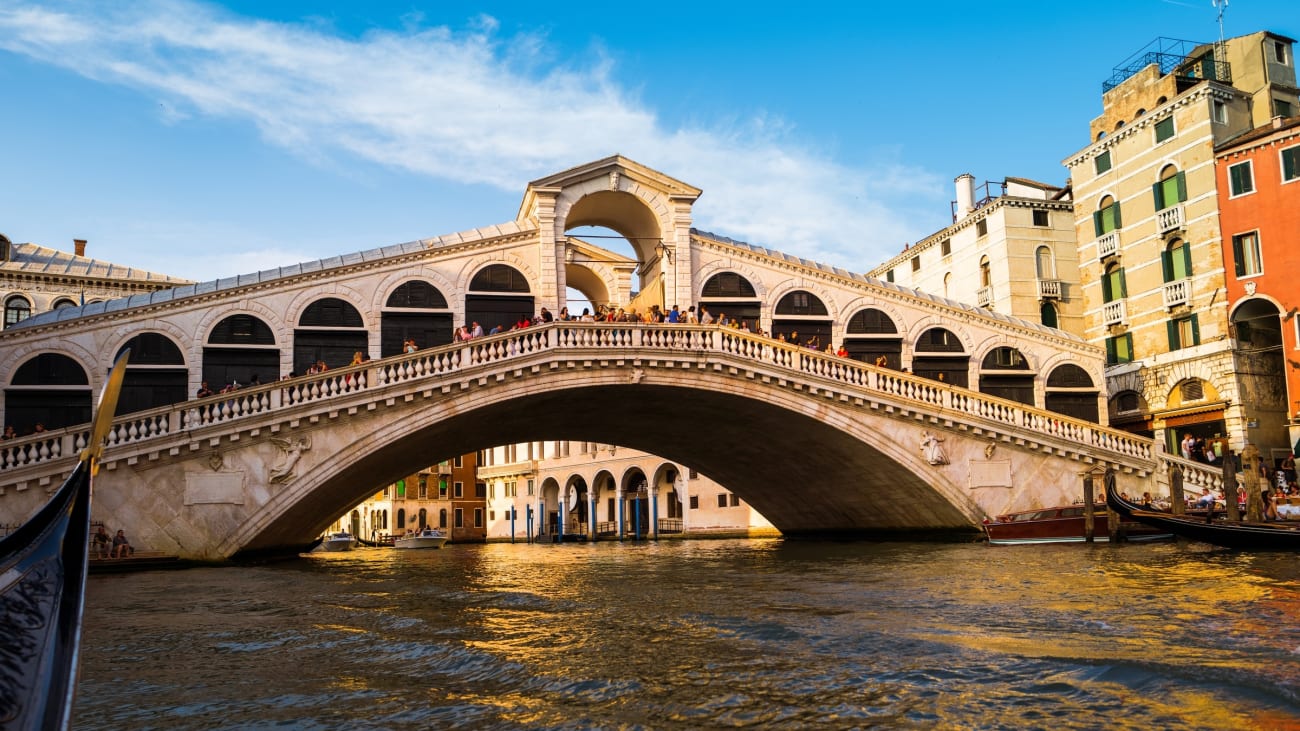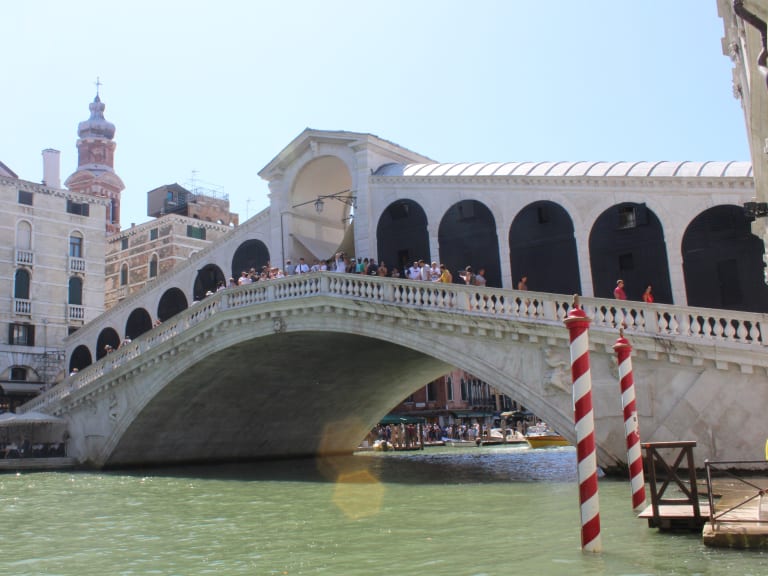10 Venice’s Best Bridges
In this post you will learn about the most famous bridges of the city, the same bridges that connect the islands of the romantic city of Venice.

Rialto Bridge, Venice | ©Vincenzo Landino
Did you know that... more than 350 bridges link the 118 islands that make up Venice? That's the reason why Venice is famous for its network of bridges and alleys that give the city a very particular atmosphere. Some of the bridges that you will learn about in this post are steeped in history and beauty, and from which you can get a view worth photographing.
1. Rialto Bridge

The Rialto Bridge is one of the four oldest bridges in Venice (built in the 16th century). It is one of the most interesting monuments to see in Venice; moreover, it is the central point of both the city and the Grand Canal.
This bridge was built between 1588 and 1591, taking only 3 years to complete. The Rialto Bridge replaced four bridges that were there before and was the only way to cross the Grand Canal on foot until 1854, when the Accademia Bridge was built.
You will see that this is a stone arch bridge that crosses the narrowest part of the Grand Canal. It has long been seen as an architectural and engineering achievement of the Renaissance. If you sharpen your eyes you will see that there are as many as 6,000 wooden piles under each abutment, all in order to support the weight of the stone arch which is what gives it that baroque feel.
How to get to Rialto Bridge
The Rialto Bridge is located in the San Polo district of Venice, joining San Marco. The 'Rialto' vaporetto stop is next door, and the bridge is easily accessible on foot from almost anywhere in Venice. Wherever you go, signs will point you in the direction of the Rialto. For your reference it's about a ten minute walk to St. Mark's.
However, if you are at the Venice airport or at another point away from the center you can opt for the bus lines (4L, 5, 6, 6L, 7E, 8E). By train you can also get there by lines (R, RV); and even by vaporetto passing through the Grand Canal thanks to lines (1 and 2).
- Address: Sestiere San Polo, 30125 Venice, Italy.
- Recommendation: Here is a post about how to move around Venice that will certainly be very useful to understand the different means of transport.
2. Bridge of the Fists

Ponte dei Pugni, or Bridge of the Fists, is another of the most famous bridges in Venice. This is because it was the place where, for years, two rival gangs clashed, the Nicolotti and the Castellani, fighting with fists.
Moreover, tradition has it that the winners threw the losers into the water, an action facilitated by the fact that, until recently, the bridge had no railing. Fortunately these fights were banned, due to their excessive violence, in 1705.
In the case of the Puente de los Puños its attractiveness is directly related to its history, since one can still observe footprints on the floor of the bridge, signs that indicated to the two rivals where to position themselves.
Near the Ponte dei Pugni there is a large boat selling fresh fruits and vegetables, a characteristic element of the place. I would also recommend photographing the Indiana Jones Library, a very famous building.
How to get to the Bridge of the Fists
The Bridge of the Fists is a small bridge located in the sestiere of Dorsoduro, halfway between Campo San Barnaba and Campo Santa Margherita. Personally I recommend walking, as the whole walk is worth appreciating calmly. Of course, if you want to cut distances I advise you to take line 1 of the vaporetto of Venice.
- Address: 30123 Venice, Italy.
3. Bridge of Sighs

The Bridge of Sighs is one of the most important bridges in Venice. It was built at the beginning of the 17th century and its name comes from the sighs heard from those who crossed the bridge and were about to be imprisoned. This theory was popularized by Lord Byron, who mentioned it throughout some of his most famous writings, which also popularized this bridge.
It is a bridge of only 11 meters and formerly gave access to the old prisons of the palace. It has a very baroque style, white color and a lot of historical weight. You know where to go if you want to relive the memories of the thousands of innocent prisoners during the long and hard Inquisition.
How to get to the Bridge of Sighs
The Bridge of Sighs is located near St. Mark's Square. To get there by train from Piazzale Roma, you can choose between the R or RV line and get off at the "Vallaresso" stop. If you prefer to go by vaporetto you can disembark near the square thanks to line 1.
- Address: Pza San Marco, 1, 30124 Venice, Italy.
4. Barefoot Bridge

The Ponte degli Scalzi (Bridge of the Barefoot) is one of the four bridges in Venice that cross the Grand Canal. It was designed by Eugenio Miozzi and completed in 1934 as a replacement for an Austrian iron bridge (all the iron bridges in Venice had been built by Austrians). The idea was to build something homegrown and to make clear evidence of Italy's rise.
If you look at the bridge, it borrows the main features of the Rialto Bridge except for the decorative lines and being built with white stone. It is undoubtedly one of the bridges you should visit at night in Venice, since from here you will be able to appreciate the illuminated cruise ships of the Grand Canal.
How to get to the Barefoot Bridge
The bridge connects the sestieri of Santa Croce and Cannaregio. To the north of the bridge are the Chiesa degli Scalzi (Church of the Barefoot Monks) and the Santa Lucia train station. To the south is the Piazzale Roma bus station. You can reach the bridge by bus lines (2, 4L, 5, 6, 6L, 7E, 8E).
- Address: Ponte degli Scalzi, 30135 Venice, Italy.
5. Accademia Bridge

Ponte dell'Accademia connects the San Marco district with Dorsoduro, where the Accademia Gallery is located. The bridge is known for offering the best views of Venice, as you can look out over the Grand Canal in both directions from a relatively high point.
Best of all, you will notice a great contrast compared to the other marble bridges in Venice, as this one was built of wood. Personally, even if you were in Venice for only one day, I would recommend you to get to this bridge as this way you will have a more global view of how the city is structured.
Also, near the bridge there are some of the best places to eat cheaply in Venice.
How to get to the Puente de la Academia
The bridge is located at the final loop of the S-shaped Grand Canal, just before the canal passes through St. Mark's Basin. I also recommend crossing the bridge if you are on your way from Piazza San Marco to the Galleria dell'Accademia, the Peggy Guggenheim Collection or the Church of Santa Maria della Salute.
The bridge can be reached preferably by vaporetto thanks to lines ( 1 and 2). Bus lines (10A , 53E , 6 , 6E , 6L , 7 , 7E , 8E ) will also serve you if you are looking to shorten distances.
- Address: 30100 Venice, Italy.
6. Straw Bridge

The Ponte della Paglia (Straw Bridge) connects the Castello district with San Marco. It was originally built in 1360 and rebuilt during the 19th century.
Its name comes from the boats that were fastened to the bridge while unloading straw to be transported to different areas. This activity was forbidden because of the risk involved. This famous bridge became an emblem for Italian painters, a detail that radically increased its popularity.
Ponte della Paglia is the perfect place to take a picture of the Bridge of Sighs, as it is located very close to the bridge .
How to get to Puente de Paja
I would recommend you to follow the path of the Bridge of Sighs and from there to the Bridge of Straw because of the proximity and the interesting path that separates them. Of course, if you are looking to get directly to the bridge I recommend the bus lines ( 10A , 24 , 4L , 6 , 6E , 6L ) or the vaporetto lines (1 or 2).
- Address: Piazzetta San Marco, 30124 Venice, Italy.
7. Calatrava Bridge

Completed in 2008, the Calatrava Bridge was designed by Spanish architect Santiago Calatrava. It is the last of the four bridges that cross the Grand Canal; it must be said that it was a controversial addition due to its modern appearance that contrasted with the Renaissance appearance of the city.
Venice's modern bridge, officially named Ponte della Constituzione, has a strong and important purpose: to connect the Santa Lucia train station with Piazzale Roma, thus linking the only area of the city accessible by car.
It is a very good spot to watch the gondola rides, or even to dare to take one.
How to get to Calatrava Bridge
The bridge is located 1.3 kilometers from the Rialto Bridge. Therefore, in order to reach the Calatrava Bridge you can opt for a cruise on the Grand Canal or opt for vaporetto line 2.
By bus the most sensible way would be to take lines 6E or 7E.
- Address: Ponte della Costituzione, 30135 Venice, Italy.
8. Bridge of the Spires

The Ponte delle Guglie is one of the two bridges that cross the Cannaregio Canal, located at its western end, near where it joins the Grand Canal.
The bridge is near the Venezia Santa Lucia train station, not far from the Rialto Bridge. You will see that the stone and brick bridge has a very ornate decoration, including gargoyles on its arch.
It is also known as the "Bridge of Spires" because of its metal spires (the only bridge in Venice with this detail).
How to get to the Bridge of Needles
This bridge is only 1 kilometer away from the Rialto Bridge, so you can easily walk there if you are in the middle of the city. You can also disembark near the bridge if you get on line 1 of the Venice vaporetto.
- Address: 30121 Venice, Italy.
9. Liberty Bridge

This bridge connects Italy with the islands that make up the city of Venice. The Ponte della Liberta used to be known as the Ponte Littorio. The bridge was inaugurated by Italian dictator Benito Mussolini in 1933 and renamed after World War II to commemorate the liberation of Italy from fascism.
If you arrive at Venice Santa Lucia station you can see the parallel of the bridge from the window. It is a bridge of 3850 meters! Nothing to do with the length of the bridges linking the islands of Venice.
This bridge, more than a place to visit, is a way to get to Venice from the city of Menestre; in other words, it is the footbridge that will welcome you to this romantic city.
10. Bridge of the Tetas

This bridge in San Polo has a long history, since it connected with the Venetian nightlife area. It is a reddish bridge, of short length and striking appearance.
To better understand the name, you have to go back to the 15th century, when the Venetian government issued a decree that allowed prostitutes to advertise their services by showing their windows and breasts (all in order to collect taxes). That practice is what eventually gave the bridge its current name.
How to get to Puente de las Tetas
Personally I recommend you to reach the Bridge of Boobs after visiting the famous Rialto Bridge, as it is only 500 meters away from it. On the way you will pass through Campo di San Silvestro and Rio de San Aponal.
- Address: Via San Cassiano, 30125 Venice, Italy.
